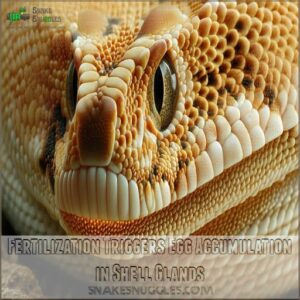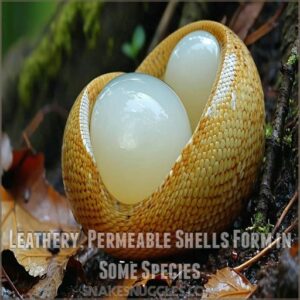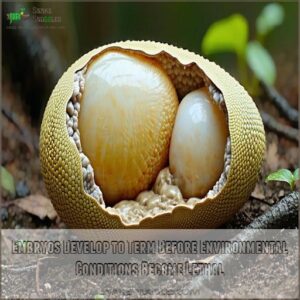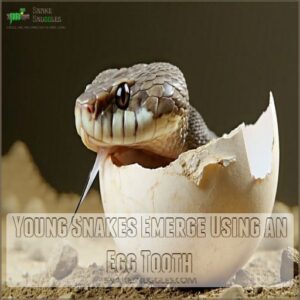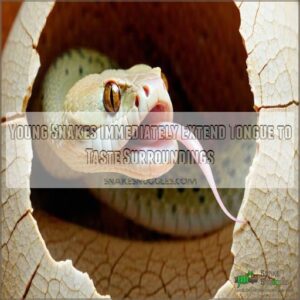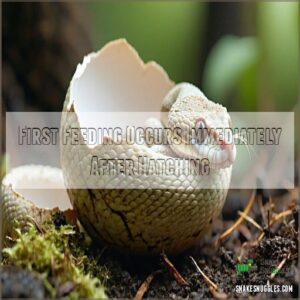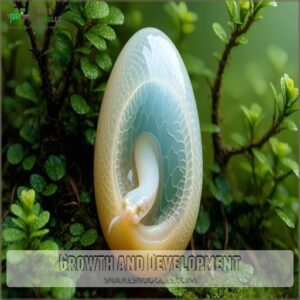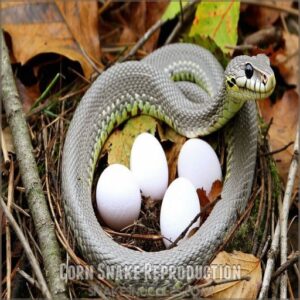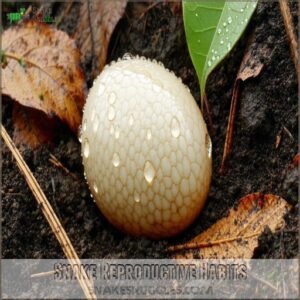This site is supported by our readers. We may earn a commission, at no cost to you, if you purchase through links.
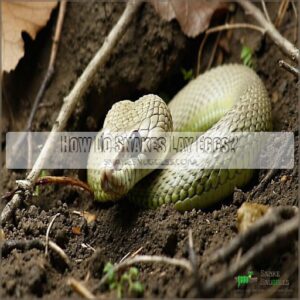 You’ll be amazed by how snakes lay eggs – it’s a fascinating process that starts with fertilization triggering special shell glands.
You’ll be amazed by how snakes lay eggs – it’s a fascinating process that starts with fertilization triggering special shell glands.
These glands create protective layers around each egg, allowing oxygen and nutrients to flow through. Most snakes form leathery, permeable shells, while some species keep their eggs inside until they’re ready to hatch.
When it’s time, mama snake uses muscle contractions to deposit her clutch, which can range from just a few to dozens of eggs that stick together.
The babies later emerge using a temporary "egg tooth" to break free, ready to taste their new world with their forked tongues.
Table Of Contents
- Key Takeaways
- How Do Snakes Lay Eggs?
- Egg Formation and Laying
- Egg Hatching and Early Development
- Venomous Snakes
- Growth and Development
- Corn Snake Reproduction
- Egg-Laying Behavior
- Snake Reproductive Habits
- Frequently Asked Questions (FAQs)
- Do snakes lay eggs or give birth?
- Do elapid snakes lay eggs?
- What snakes do not lay eggs?
- Do sea snakes lay eggs?
- How do the eggs come out of the snake?
- Do some snakes lay eggs from their mouths?
- How does a snake give birth?
- How can a snake lay eggs without a male?
- Can female snakes lay eggs without a male?
- Where do snakes keep their eggs in their body?
- Conclusion
Key Takeaways
- You’ll find that 70% of snake species lay eggs through their cloacae, while others give birth to live young or keep eggs inside until they hatch.
- Your snake’s eggs develop when fertilization triggers specialized shell glands to create protective, leathery layers that allow oxygen and nutrients to flow through.
- You can observe baby snakes using a temporary egg tooth to break free from their shells, immediately using their forked tongues to taste their surroundings.
- You’ll notice that female snakes can lay eggs without males through parthenogenesis, though these offspring often have reduced survival rates and weaker immune systems.
How Do Snakes Lay Eggs?

Ever wondered how snakes bring new life into the world? Most snakes lay eggs, though the process varies dramatically among species.
Imagine this: a female snake carefully selects a hidden spot, often under logs or in abandoned burrows, to lay her precious clutch. While about 70% of snake species lay eggs (called oviparous), others have evolved different approaches, such as ovoviviparous snake reproduction. Some give live birth (viviparity), while others incubate eggs internally until they hatch (ovoviviparity).
The number of eggs can range from just a couple to over fifty, depending on the species.
Take the king cobra, for example – it’s quite the architect, building elaborate nests to protect its eggs. Whether they’re soft-shelled or hard-shelled, these eggs are perfectly adapted to their environment, ensuring the next generation’s survival.
Egg Formation and Laying
You’ll find that snake egg formation starts when fertilization triggers specialized shell glands to create protective layers around each developing embryo.
While most snakes lay eggs with soft, leathery shells that allow oxygen and moisture to pass through, you’ll discover that some species keep their eggs inside until they’re ready to hatch.
Fertilization Triggers Egg Accumulation in Shell Glands
Inside your snake’s body, a remarkable process begins after mating. When fertilization happens, specialized shell glands kick into action, carefully building each egg layer by layer. These glands don’t just create a shell – they’re architectural masterpieces that guarantee proper gas exchange and nutrient flow.
Here’s what’s happening inside:
- The shell glands work like tiny factories, assembling protective layers
- Each egg gets its own custom-built home
- The timing of fertilization determines the egg’s final shape
- Special channels form to let the developing snake breathe
Leathery, Permeable Shells Form in Some Species
A snake’s leathery eggs are marvels of natural engineering.
Unlike rigid bird eggs, these flexible shells act like living membranes, letting oxygen and water pass through to nourish the developing embryo.
This process is made possible by the shell glands facilitating gas exchange.
You’ll find these soft-shelled eggs particularly common in water-loving snakes, where their permeable nature helps them adapt to damp environments.
Think of them as nature’s perfect incubators, designed for survival in hidden, moist spaces.
Ovoviviparous Development: Embryo Retained in Oviduct With Material Layers
While some snakes lay eggs with hard shells, ovoviviparous species do things differently.
The embryo stays protected in the mother’s oviduct, wrapped in special tissue layers instead of a traditional shell.
For those interested in learning more about these unique creatures, there are various products available related to ovoviviparous snake care.
Think of it as nature’s version of a built-in incubator. The developing snake gets nutrients directly from mom, and when it’s ready, it hatches right inside her before emerging fully formed.
Egg Hatching and Early Development
You’ll find it fascinating to watch as baby snakes use their special egg tooth to break free from their shells, immediately tasting their new world with quick flicks of their tongues.
Once they’ve emerged, these tiny reptiles won’t wait around for mom’s help – they’re ready to hunt their first meal right away, equipped with all the instincts they need to survive.
Embryos Develop to Term Before Environmental Conditions Become Lethal
Nature’s perfect timing guides snake embryo development within their eggs, orchestrating a fascinating race against environmental conditions. Like a well-choreographed dance, these tiny beings develop in sync with their surroundings:
- Temperature fluctuations trigger precise developmental stages
- Oxygen levels through porous shells regulate growth rates
- Humidity balance maintains ideal moisture conditions
- Seasonal cues time development for ideal hatching conditions
This remarkable process guarantees maximum survival rates during the critical incubation period.
Young Snakes Emerge Using an Egg Tooth
Just before a baby snake enters the world, it develops a fascinating tool: the egg tooth. This temporary, sharp projection helps the hatchling cut through its leathery shell – think of it as nature’s built-in escape tool.
Here’s what happens during this important moment:
| Stage | Duration | Key Features |
|---|---|---|
| Pre-break | 1-2 hours | Egg tooth forms |
| Breaking | 15-30 min | Shell cutting |
| Emergence | 5-10 min | Final push |
Young Snakes Immediately Extend Tongue to Taste Surroundings
Fresh from breaking through their shells, baby snakes immediately put their forked tongues to work.
You’ll see these tiny creatures flicking their tongues rapidly, as if tasting the air around them.
This natural behavior isn’t just cute – it’s how they build their first sensory map of the world, picking up chemical signals that tell them about nearby threats and safe spaces.
First Feeding Occurs Immediately After Hatching
When baby snakes burst out of their eggs, they’re ready to tackle their first meal right away. You’d be amazed at their survival instincts!
Here’s what happens in those important first moments:
- Their digestive system activates within hours of hatching
- They can detect prey using their brand-new heat-sensing pits
- Most will successfully catch prey within 24-48 hours
- Their first meal is typically 40% of their body weight
Venomous Snakes
You’ll be amazed to learn that baby venomous snakes emerge from their eggs with fully working venom glands and fangs, ready to protect themselves.
They’ll shed their egg tooth right after hatching and quickly experience their first skin sloughing, marking their change into independent hunters.
Born With Functional Venom Glands and Fangs
Here’s a fact that might surprise you: baby venomous snakes emerge from their eggs fully armed.
Unlike many other animals that need time to develop their defenses, these tiny predators come equipped with functional venom glands and ready-to-use fangs.
They’re like nature’s miniature warriors, born with everything they need to survive. Even more fascinating, some species, like young viperids, sport bright green tail tips to lure their prey. fully armed baby venomous snakes
Capable of Immediate Venom Utilization
Baby venomous snakes hit the ground running with fully loaded venom glands from day one. While their adult counterparts possess functional venom and fangs, these tiny predators come equipped with everything they need to hunt effectively:
- Their venom is often more concentrated than adults’
- They can accurately strike and inject venom immediately
- They possess precise control over venom deployment
- Their metabolism efficiently produces new venom within hours
Egg Tooth is Shed Shortly After Birth
Venomous snakes possess a remarkable tool for their grand entrance into the world – the egg tooth.
This temporary tooth serves just one purpose: breaking through the shell.
Once the baby snake emerges, nature’s perfect timing kicks in as the tooth naturally detaches.
Think of it as nature’s special delivery package – there when needed, gone when the job’s done.
First Sloughing of Skin Occurs Soon After Birth
Shortly after emerging from their eggs, young snakes undergo their first skin shedding – an important milestone in their development.
You’ll notice this process happening within days of birth, right after they’ve shed their egg tooth.
During this time, they’re already equipped with functional venom glands and fangs, making them fully capable hunters. This first molt signals they’re ready to feed and grow independently.
Growth and Development
You’ll notice that your snake’s growth rate depends heavily on how much food it gets and the temperature of its environment.
Just like teenagers during a growth spurt, snakes grow quickly until they reach sexual maturity, which is when they’re ready to start families of their own.
Growth Rate Correlates With Food Availability and Temperature
After emerging from their eggs, a snake’s growth journey depends on two key factors: food and temperature. You’ll notice your snake grows faster when it has plenty to eat and maintains ideal temperatures (usually between 75-85°F).
Here’s what impacts their growth:
- Regular feeding schedules boost growth rates
- Ideal temperatures support metabolism
- Quality prey items enhance development
- Environmental stability promotes healthy growth
Snakes Grow Rapidly Until Sexual Maturity
Your snake’s growth journey is like a rocket launch – explosive at first, then leveling off.
During the first two years, you’ll witness remarkable development as your pet races toward sexual maturity, requiring specific care with the right snake breeding supplies.
While indeterminate growth continues throughout their life, the pace slows considerably after maturity. This rapid early development equips young snakes with everything they need to thrive and eventually reproduce.
Corn Snake Reproduction
You’ll find corn snakes fascinating because they’re egg-layers.
They can produce clutches even without a male present, thanks to their ability to store sperm or reproduce through virgin birth.
In fact, female corn snakes are born with eggs already in their ovaries, making them natural-born moms-to-be who’ll lay their first clutch when conditions are just right.
Oviparous (egg-laying) Species
Growth patterns in snakes naturally lead us to one of nature’s most fascinating processes: egg-laying in corn snakes.
These oviparous reptiles demonstrate remarkable reproductive abilities, particularly in how they manage fertilization.
Female corn snakes possess specialized organs that can store sperm for months after mating, ensuring successful reproduction even when male encounters are rare. This adaptation maximizes their chances of producing viable offspring.
Can Lay Unfertilized Eggs
Corn snakes regularly lay unfertilized eggs, even without male contact. Think of it as nature’s backup plan – these eggs won’t hatch, but they show the snake’s reproductive system is working.
- The eggs appear similar to fertilized ones initially
- They often collapse or discolor within days
- Some snakes lay multiple unfertilized clutches yearly
- Failed clutches don’t harm the snake’s future fertility
Eggs in Ovaries From Birth
The remarkable world of corn snake reproduction begins at birth, with females carrying immature egg cells in their ovaries from day one.
While these eggs aren’t ready for fertilization immediately, they’re nature’s way of preparing for future reproduction.
| Feature | Early Stage | Mid Stage | Late Stage |
|---|---|---|---|
| Egg Size | Microscopic | 2-3mm | 4-6mm |
| Development | Dormant | Growing | Maturing |
Female Corn Snakes Can Store Sperm
Female corn snakes possess a remarkable reproductive superpower – they can store sperm for months after mating.
This ability isn’t unique to corn snakes, as some snake species, such as the western diamond-backed rattlesnake, can store sperm for long-term sperm storage.
You’ll find this ability particularly fascinating since it means they don’t need constant male companionship to produce viable eggs.
This sperm storage mechanism lets females wait for ideal conditions before fertilizing their eggs, while also mixing genetic material from multiple mates to create healthier, more diverse offspring.
Parthenogenesis (virgin Birth) Possible
Following those egg-storing abilities we discussed, here’s something wild: corn snakes can actually give birth without any male involvement through parthenogenesis.
Think of it as nature’s backup plan.
But there’s a catch – this self-cloning comes with three major downsides:
- Limited genetic diversity in offspring
- Reduced survival rates compared to normal reproduction
- Weaker resistance to diseases and environmental changes
Egg-Laying Behavior
You’ll find that snake egg-laying isn’t always successful.
A female laid just five eggs before stopping completely.
When these eggs began turning brown, it was a clear sign they weren’t viable.
This shows how complex and sometimes uncertain snake reproduction can be.
Laid Five Eggs
After successful mating, a corn snake carefully deposited five pristine eggs in a secluded spot.
You’ll notice these eggs are distinctively oblong and wrapped in soft, leathery shells – nature’s perfect packaging.
While five eggs might seem modest, it’s actually quite normal for corn snakes. They’re instinctively drawn to damp, hidden locations that provide ideal conditions for their developing offspring.
Eggs Began to Brown, Suggesting Inviability
The brownish discoloration of snake eggs tells an important story about their health.
You’ll notice this color change typically signals trouble – it’s a classic sign of inviability or failed development.
Think of it like watching fruit turn brown; it’s nature’s way of indicating something’s not quite right.
For snake breeders and enthusiasts, this coloration serves as a helpful visual indicator that these eggs likely won’t produce healthy hatchlings.
Egg-laying Ceased at Five
Snake egg-laying stopped once five eggs emerged, signaling potential reproductive challenges.
This matches typical clutch sizes for smaller snake species, though various factors like temperature, humidity, and maternal health play key roles.
When egg production halts early, it’s worth monitoring the existing eggs closely – their color and texture can reveal important clues about their development and viability.
Unsuccessful Attempt at Reproduction
Reproducing snakes face several challenges that can lead to unsuccessful breeding attempts. Common issues include infertility, low sperm count, or unsuitable environmental conditions.
You’ll notice signs of trouble when eggs turn brown or show other discoloration.
Temperature fluctuations and improper humidity levels often contribute to egg rejection.
It’s important to monitor your snake’s reproductive health and maintain stable breeding conditions to improve success rates.
May Not Lay Eggs Again
Failed attempts at egg-laying don’t always mean your snake won’t produce future clutches. After an unsuccessful breeding season, here’s what you’ll want to watch for:
- Changes in feeding patterns that might signal reproductive stress
- Behavioral shifts indicating hormonal imbalances
- Physical signs like weight loss or lethargy
To maintain proper humidity in their habitat, consider investing in a reliable reptile humidity gauge.
Whether your snake lays again depends heavily on maintaining proper temperature (78-82°F) and humidity (70-80%) in their habitat.
Snake Reproductive Habits
You’ll be surprised to learn that not all snakes lay eggs, as some species like garter snakes give birth to live young while others, such as rattlesnakes, keep their eggs inside until they hatch.
When male snakes aren’t available, some female snakes can actually reproduce on their own through a process called parthenogenesis, though these offspring often aren’t as healthy as those from regular mating.
Garter Snakes Are Viviparous (give Birth to Live Young)
Among reptiles, the humble garter snake stands out with its fascinating live birth process.
Unlike most snakes that lay eggs, these remarkable creatures carry their developing young internally through complete gestation.
You’ll typically find mothers giving birth to 10-40 fully formed babies, each ready to tackle life independently.
What’s particularly intriguing is that these newborns receive no parental guidance – they’re instantly equipped for survival.
Rattlesnakes Are Ovoviviparous (eggs Hatch Internally)
Unlike their egg-laying cousins, rattlesnakes keep their babies safe inside through ovoviviparity – a fascinating reproductive strategy.
You’ll find their embryos developing within internal egg layers, protected from harsh conditions and hungry predators.
When it’s time, these eggs hatch inside mom, leading to live birth of fully-formed snakelets.
This internal incubation system gives rattlesnake babies a head start in survival.
| Trait | Ovoviviparous Rattlesnakes | Viviparous Garter Snakes | Oviparous Corn Snakes |
|---|---|---|---|
| Development | Internal | Internal | External |
| Egg Hatching | Internal | N/A | External |
| Birth Method | Live Birth | Live Birth | Egg Laying |
| Embryonic Nourishment | Internal Egg Layers | Placenta | Yolk |
| Protective Strategy | Internal Hatching | Internal Gestation | External Nest |
Parthenogenesis Occurs in The Wild When No Males Present
You might be surprised to learn that female snakes can have babies without ever meeting a male – it’s called parthenogenesis.
This remarkable process happens naturally in some snake species when populations become isolated.
Scientists have documented this "virgin birth" in both captive and wild snakes, including pythons, boas, and pit vipers.
It’s nature’s backup plan for when males aren’t around.
Offspring From Parthenogenesis May Not Be Healthy
While the ability to reproduce without males sounds impressive, parthenogenetic snake offspring face serious health challenges. Think of it like making copies of copies – each generation loses some clarity.
Additionally, many parthenogenetic snakes are oviparous, laying eggs that vary in size depending on the species, as seen in snake reproduction methods.
Here’s what makes these snake babies vulnerable:
- Weakened immune systems that struggle to fight off common infections
- Reduced survival rates in the wild
- Limited reproductive capabilities, often leading to infertility
Frequently Asked Questions (FAQs)
Do snakes lay eggs or give birth?
Just as nature loves variety, snakes showcase diverse reproductive methods.
Most snakes (70%) lay eggs, while others give birth to live young.
You’ll find three distinct types: egg-laying, live birth, and egg retention.
Do elapid snakes lay eggs?
Elapid snakes are egg-layers (oviparous), including familiar species like cobras, mambas, and coral snakes. They’ll typically deposit their clutch in hidden, warm locations and may guard them until hatching.
What snakes do not lay eggs?
You’ll find that boa constrictors, green anacondas, and most sea snakes give birth to live young through viviparity, while rattlesnakes use ovoviviparity, where eggs hatch inside before birth occurs.
Do sea snakes lay eggs?
Most sea snakes give birth to live young.
But there’s an interesting exception: the sea krait (Laticauda genus).
These unique creatures actually lay their eggs on land, usually in coastal caves or rock crevices.
How do the eggs come out of the snake?
Snakes give birth to eggs through their cloaca, a special opening at the tail end.
During this process, they’ll twitch and breathe rapidly.
while using powerful muscular contractions to push each egg out one-by-one.
Do some snakes lay eggs from their mouths?
Despite popular myths, it’s not possible for snakes to lay eggs through their mouths.
They’re equipped with a specialized reproductive system that releases eggs through their cloaca, located near the tail.
How does a snake give birth?
Depending on the species, you’ll find snakes giving birth in two ways: most lay eggs (like pythons),
while others deliver live babies (like boas).
Some even keep eggs inside until they’re ready to hatch.
How can a snake lay eggs without a male?
Female snakes can produce viable eggs through parthenogenesis, a process where they don’t need male fertilization.
This is relatively rare in snake populations.
You’ll find this happens in some species like Komodo dragons, though it’s relatively rare in snake populations.
Can female snakes lay eggs without a male?
While it might surprise you, many snake species can lay unfertilized eggs without a male through parthenogenesis.
This fascinating process is mostly found in pythons and boas.
The eggs, however, won’t produce viable offspring.
Where do snakes keep their eggs in their body?
Snake eggs develop in special oviducts within their lower body cavity.
These tube-like structures connect to the cloaca and provide nutrients to the developing eggs.
Before they’re laid through the same opening.
Conclusion
Nature finds a way, as they say, and that’s certainly true for how snakes lay eggs.
Whether they’re depositing leathery shells in hidden nests or keeping their eggs safely inside until they hatch, these remarkable reptiles have evolved fascinating reproductive strategies.
You’ve learned how different species approach reproduction, from the egg-laying corn snake to live-bearing garter snakes.
Understanding how snakes lay eggs gives us a deeper appreciation for these incredible creatures and their diverse reproductive adaptations.

